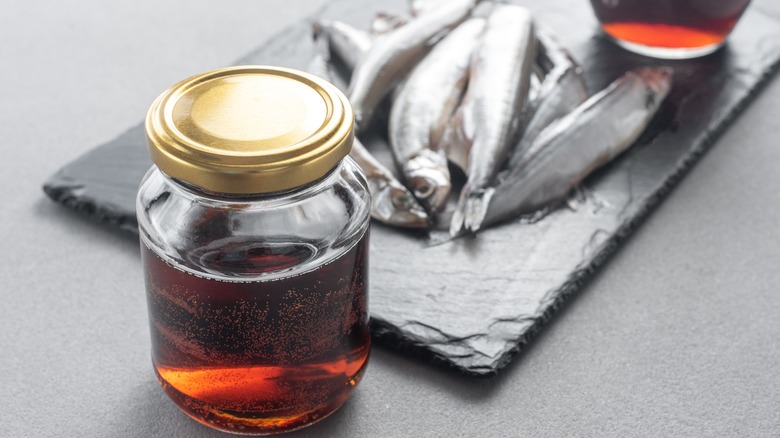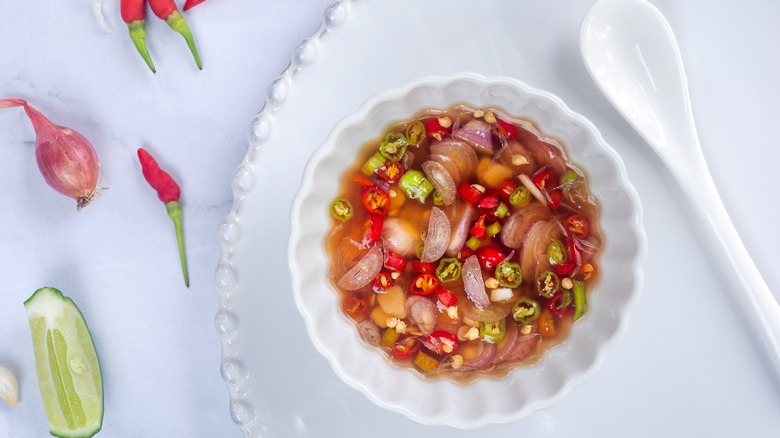The Difference Between Thai And Vietnamese Fish Sauce
Take a quick glance into the pantries of Southeast Asian kitchens, and there's a good chance you'll find a bottle of fish sauce already sitting on those shelves. This condiment is an irreplaceable part of many of the cuisines in those regions and countries. Fish sauce is incorporated into countless dishes — from traditional to modern ones — and even beyond, to other parts of the continent.
So what exactly is fish sauce, and is it actually made from fish? The answer is yes, salted fermented fish, to be more specific. Through a fermentation process with oily fish (often anchovy), salt, and water over up to two years, this amber liquid is packed with an umami richness that makes it an exceptional flavor enhancer.
Thai and Vietnamese fish sauce are, arguably, two of the most common varieties. Similar as they may be in production, these two are not the same thing. Their differences lie not only in origin and name but also in their taste and level of saltiness. While brininess and a pungent scent are the defining characteristics of both, Vietnamese fish sauce (also known as nuoc mam) is lighter than its Thai counterpart, nam pla. This, of course, leads to different flavor impacts and applications. Unsurprisingly, you'll find nuoc mam in Vietnamese dishes and nam pla in Thai food. That said, they can be used interchangeably to fit your personal preferences.
Find flavor intensity with just a few drops of Thai fish sauce
Thai fish sauce packs a punch that can overtake your senses from the very first taste. One whiff and you'll immediately smell the strong fishy scent. No less potent are the salty, funky notes that lend an umami richness to anything they touch. Certain brands also add sugar, hydrolyzed wheat protein, or other ingredients to lessen the sharpness.
If you're a fan of Thai food, you've probably tasted fish sauce before, especially in the widely beloved prik nam pla. It's a dipping sauce made by mixing fish sauce with Thai chilies, lime juice, aromatics such as garlic and shallots, and sometimes sugar for those who favor sweetness. You'll easily find it side by side with various Thai dishes, from fried rice and noodles to hearty cooked meat and salad (notably a raw shrimp Thai salad called kung chae nampla).
With such a distinctive boldness, nam pla is already quite phenomenal by itself and can be used for pretty much any Thai dish you can think of. Thai curry often uses this condiment to take things up a notch and strike a contrast with the creamy coconut base. Similarly, Thai soups such as tom kha khai or tom yum also benefit greatly from this sauce's flavor-boosting wonder. Pad Thai, yet another worldwide favorite, also relies on fish sauce to achieve an umami balance that makes it so well-loved.
Vietnamese fish sauce is comparatively milder and sweeter
Vietnamese fish sauce is far from delicate or subtle, but compared to the Thai rendition, it's relatively milder. The signature brininess and fishy aroma are still prominent, but not in the assertive way you might find nam pla to be. Nuoc mam, instead, is only bold enough to impart flavors. Hidden underneath are sweet nuances that round out the overall taste. In fact, it can be used as a salt substitute in many dishes (soups, stews, and stir-fries, to name a few), where it not only offers saltiness but also flavor complexity.
One of nuoc mam's main applications is nuoc cham — an all-purpose dipping sauce made from ingredients similar to prik nam pla. Its tumultuous mixture of savory, sweet, zesty, and spicy notes works with almost any Vietnamese dish. With meat, it's both a marinade and a dip, infusing the food with its vibrancy. Splash a few drizzles over salads and you've got a fresh yet punchy side dish to complete the meal. From spring rolls and com tam (Vietnamese broken rice) to banh xeo and many more, it's the timeless companion that never disappoints.
Needless to say, when it comes to versatility, both Vietnamese and Thai fish sauce have in spades, so despite the subtle differences, you don't have to think too much when choosing between the two. Opt for the Thai variety if you're aiming to make authentic Thai dishes or simply want a flavor kick. Vietnamese fish sauce, meanwhile, holds a special charm that captivates the taste buds just right. Either way, your meal is certain to be memorable with this staple condiment.


